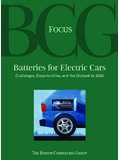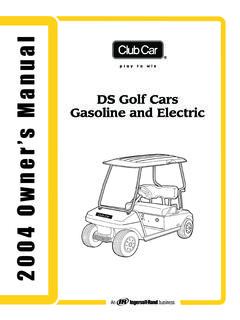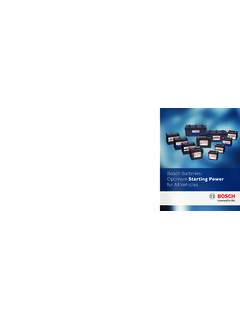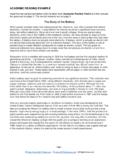Transcription of Golf Cart Maintenance Guide Watering Your Battery
1 Golf Cart Maintenance Guide Watering your Battery There are two conditions when Watering can be harmful to your batteries . One is over- Watering and the other is under Watering . It seems like most everyone does one or the other. In our recent meeting with the Trojan Battery gurus, they told us that over- Watering is perhaps more harmful to the batteries than under Watering , but they are both bad for the batteries . So we will discuss over- Watering first. Over- Watering your batteries The electrolyte in a Battery is the solution of water and sulfuric acid. During the normal process of charging and discharging the level of the electrolyte changes rather drastically. This is normal. It is also normal in the process of charging to lose some of the electrolyte. We'll explain how this happens in a moment.
2 So it is necessary periodically to bring the electrolyte level to a correct level by adding water and distilled water is HIGHLY recommended. But adding water is where things can get screwed up. This is how it happens. You come home from playing a round of golf and think, just before you recharge the batteries , "Gosh, I'd better check the batteries . I haven't put water in them for quite some time." So you open up the Battery compartment and remove the caps guarding the cells and low and behold, the electrolyte level is low. So you get a jar or can and fill it with tap water and start pouring it into the cells. Oops, got too much in that one, its overflowing. Oh well, not to worry. Wrong! Wrong! Wrong! You just made three mistakes, all bad for your batteries . Mistake No.
3 1 -- Do Not Fill Discharged batteries In fully charged batteries the electrolyte should be at its highest optimum level. As you discharge the batteries , the level of the electrolyte will decrease as a normal chemical process of the batteries . When you recharge the batteries , the level of the electrolyte will return to its optimum level. If you water Battery when it is discharged, you will most likely over water because the level of the electrolyte will increase when you charge those batteries . Do not -- repeat -- do not water any discharged Battery . The correct way to water a Battery is to first fully charge it, check the level of the electrolyte then add water to bring the electrolyte to the optimum level. The only exception to this is if the tops of the plates are exposed.
4 Then add water to cover the plates, charge the batteries and then check the electrolyte level to the correct level. Mistake No. 2 -- Do Not Use Tap Water in your batteries OK, there are certain water supplies that contain absolutely pure water, but that is rare. In most cases tap water contains minerals that are harmful to your Battery . Even if there are just trace minerals, over four or five years of Battery life these contaminants can add up. The Trojan Battery people sent us a long list of bad things common in tap water. One of the worst is water that has been softened by commonly used water softeners. Water softeners leave chlorides in the water and they are very bad for batteries . A new set of batteries for your golf car will cost you about $450, distilled water is inexpensive.
5 So here is another rule: Use Only Distilled Water in your batteries . Mistake No. 3 -- Do Not Fill Cells to Overflowing If you water discharged batteries to a point where they will overflow when charged, or if you water to overflow the fully charged batteries , you will deplete the electrolyte of the necessary mixture of acid and water. In this condition the Battery will not deliver its proper level of energy. Furthermore it will put corrosive acid all over the place. Now you better clean-up the mess or suffer the consequences. Do not assume that the acid will not hurt the aluminum Battery racks of Club Car. Battery acid will eat away the aluminum as well as steel racks Under Watering batteries In our 25 years of golf car Maintenance we find that under Watering is the most common cause of Battery damage.
6 The dumbest statement we have heard about comes from the Maintenance supervisor of a large golf course. When asked who did the Maintenance on his electric golf car fleet he replied, "Nobody. We don't have to do Maintenance . These golf carts are leased." Most of the cars had little water in the batteries and they were failing right and left. If the electrolyte level is below the plates, the exposed portion cannot engage in the chemical process which results in power from the Battery . If the plates are exposed repeatedly or are out of the electrolyte for extended periods of time, a process called sulfation will occur. In this process the active material will turn to a sulfate, which is irreversible. That portion of the Battery is dead forever. A sulfate also has a nasty habit of flaking off and falling to the bottom.
7 This will eventually short out the plates and bye-bye Battery . So as far as Watering goes, it is, "Dammed if you do -- and Dammed if you don't." How Often Should You Water your batteries ? The simple answer is, "Whenever it is needed." OK, OK when will it be needed? Well, that is the direct function of Battery age and how often you use your batteries . The more often the Battery is used, the more electrolyte is expelled in the process of what is called 'gassing'. We will talk about that a little later. The batteries will definitely not need water every time you use them, but a good rule of law and is to check them, say, once a month. As batteries age they will need to be checked more frequently. In warmer climates the water will evaporate faster. What Is Gassing in a Battery ?
8 Is Gassing Bad? No, gassing is good and a normal phenomenon in the process of recharging a Battery . When you discharge a Battery the sulfuric acid in the electrolyte is "consumed" by the active material on the plates. When the Battery is recharged, the acid is liberated and returns to the electrolyte. But this acid is heavier than water and tends to drop to the bottom. At about 80 or 85 percent of the full charge nearly all of the acid is returned to the electrolyte. The Battery people say that the charging process is not completed because the electrolyte is stratified. This essentially means that most of the acid is that the bottom and most of the water is at the top. That condition is not satisfactory for discharging the Battery again. This is where is where gassing comes in.
9 As the charging process continues the electrolyte begins to bubble or gas. This gassing, as it is called, is necessary to return the electrolyte to an even consistency. In the Battery business it is called returning to the correct specific gravity. Now there is a small problem with gassing. The gas escapes from the Battery and carries with it a small amount of the sulfuric acid. This acid can corrode the terminals, corrode the hold down brackets, corrode the Battery frame holder and just about any other metal it touches. It is no major catastrophe unless you ignore it. We will talk about that under ' corrosion care'. What Is the Optimum Level of the Electrolyte? The diagram below shows the optimum level of the electrolyte in each cell when the Battery is fully charged.
10 Want a no brainer? Buy yourself a Battery filler bottle (pitcher). Put distilled water in the pitcher then put the filler spout down into a cell. Water will not come out until you press down because the spout is spring loaded. Press down and the cell will automatically fill to the correct level. These filler bottle only cost about $15 to $20 at many pro shops and golf cart shops. Charging and Discharging your batteries When and How Often Should I Charge the batteries ? There are a lot of different opinions out there on this question. We have read conflicting viewpoints. So when we met with the Trojan Battery experts, we asked them this question. Their answer was to recharge the batteries every time you discharge them. That's simple enough. How Far Down Should I Discharge the batteries ?








